ODISSI OF ODISHA
ODISSI: ORISSA,one of the earliest dance form . It is referred as "mobile-Sculpture" as it is a graceful sensuous and lyrical , Odissi is a dance of love and passion touching on the divine and the human, the sublime and the mundane. The Natya Shastra mentions many regional varieties, such as the south-eastern style known as the Odhra Magadha which can be identified as the earliest precursor of present day Odissi..
 |
| ODISSI |
Archaeological evidence of this dance form dating back to the 2nd century B.C. is found in the caves of Udayagiri and Khandagiri near Bhubaneshwar. Later, innumerable examples of the Buddhist sculptures, the tantric images of dancing Yoginis, the Nataraja, and other celestial musicians and dancers of early Shaivite temples bear testimony to a continuing tradition of dance from the 2nd century B.C.E to the 10th century C.E. These influences found synthesis in an unique philosophy - the dharma or faith of Jagannath. With Hinduism taking roots in Orissa by about the 7th century A.D., many imposing temples were erected. The magnificent Sun Temple at Konarak, built in the 13th century, with its Natya mandap or Hall of dance, marks the culmination of the temple building activity in Orissa. These dance movements, frozen in stone, continue to inspire Odissi dancers even today.
For centuries maharis were the chief repositories of this dance.
The MAHARIS, who were originally temple dancers came to be employed in royal courts which resulted in the degeneration of the art form. Around this time, a class of boys called gotipuas were trained in the art, they danced in the temples and also for general entertainment. Many of today's gurus of this style belong to the gotipua tradition.
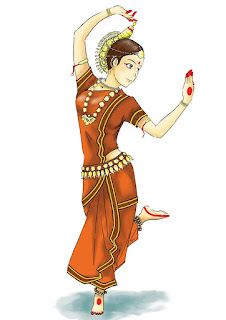 |
| A MAHARI/DEVADASI |
Odissi is a highly stylised dance and to some extent is based on the classical Natya Shastra and theAbhinaya Darpana. In fact, it has derived a great deal from the Abhinaya Darpana by Jadunath & the Abhinaya Chandrika by Maheshwara Mahapatra.
As in other parts of India, creative literature inspired the Odissi dancer also and provided the themes for dance. This is especially true of the 12thcentury Gita Govinda by Jayadeva. The "Ashtapadis" of Jaydeva has had become a part and parcel of its repertoire .It is a profound example of the"nayaka-nayika" bhava and surpasses other poems in its poetic and stylistic content. The devotion of the poet for Krishna permeates through the work.
Odissi closely follows the tenets laid down by the Natya Shastra. Facial expressions, hand gestures and body movements are used to suggest a certain feeling, an emotion or one of the nine rasas.
The techniques of movement are built around the two basic postures of the Chowkand the Tribhanga. The chowk is a position imitating a square - a very masculine stance with the weight of the body equally balanced. The tribhanga is a very feminine stance where the body is deflected at the neck, torso and the knees. The torso movement is very important and is an unique feature of the Odissi style. With the lower half of the body remaining static, the torso moves from one side to the other along the axis passing through the centre of the upper half of the body.
Great training is required for this control so as to avoid any shoulder or hip movement. There are certain foot positions with flat, toe or heel contact. These are used in a variety of intricate combinations. There are also numerous possibilities of leg movements. Almost all leg movements are spiral or circular, whether in space or on the ground.
 |
| ODISSI |
In addition to the leg movement, there are a variety of gaits for doing pirouettes and jumps and also certain postures inspired by the sculptures. These bhangis, as they are called are really units of movement ending in one particular stance.
Hand gestures play an important role both in nritta where they are used only as decorative embellishments and in nritya where they are used for communication.
The formal repertoire of Odissi has a certain order of presentation, where each successive item is systematically put together to produce the desired rasa.
The opening item is MANGAL-ACHARAN where the dancer slowly enters the stage with flowers in her hands and makes an offering to mother earth.
This is followed by an invocation to the deity of the dancer's choice. Generally, Ganesha is called upon to grant an auspicious beginning. The item ends with a nritta sequence with salutations to God, the Guru and the audience.
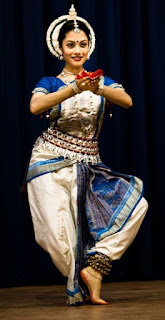 |
| MANGAL-ACHARAN |
The next item is called BATU where the basic concepts of the Odissi nritta technique are highlighted bringing out the duality of the masculine and the feminine through the
basic stance of the chauk and tribhanga. This is danced in praise of BatukeshwarBhairav or Shiva. The accompanying music is very simple -only a refrain of dance syllables.
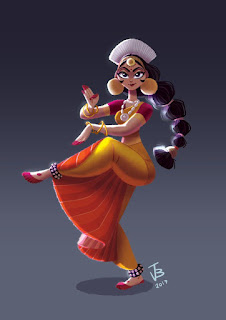 |
| BATUNRITY |
After the very basic exposition of nritta in Batu, comes the flowering and
ornamentation of music and movements in PALLAVI. A musical composition in a particular raga is visually represented by the dancer with slow and subtle movements, building up into complex patterns highlighting rhythmic variations within the talastructure. PALLAVI-is elaborating a song through graceful movement and facial expressions and interspersed with pure dance and poses.
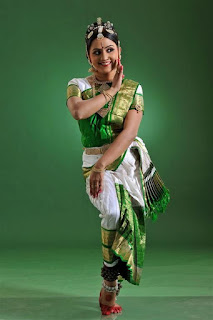 |
| PALLAVI |
This is followed by the rendering of abhinaya-"Tharijham". Orissa has a continuing tradition of dancing of the" Ashtapadis" Jayadeva's Gita Govinda since the 12th century. The lyricism of this poem is particularly suited to the Odissi style. Apart from the Gita Govinda, the compositions of other Oriya poets like Upendra Bhanja, Baladeva Ratha, Banamali and Gopal Krishna are also sung.
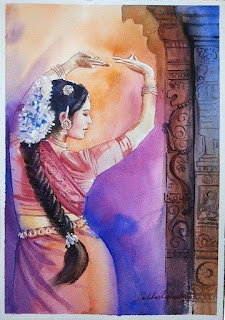 |
| MOKSHA |
The concluding item of the repertoire, which may consist of more than one pallavi and items based onabhinaya, is called MOKSHA. Pakhawaj syllables are recited and the dance moves from slow to quick sequences to reach a climax, when the dancer pays the final obeisance.
There's another way of concluding dance and i.e. TRIKHAND MAJURA indicating a leave-taking from the gods, the audience and the stage.
 |
| TRIKHAND MAJURA |
An Odissi orchestra essentially consists of a pakhawaj player (usually the Guru himself), a singer, a flutist, a sitar or violin player and a manjira player.
The dancer is adorned in elaborate Oriya silver jewellery and a special hair-do. The sari, usually stitched nowadays, is unique to the style.
In each performance, even a modern Odissi dancer still reaffirms the faith of the devadasis ormaharis where they sought liberation or moksha through the medium of dance.


Very nice Post, thank you.
ReplyDeleteOdia Spiritual Book Biswamitranka Atmakatha
Order Odia Books
Odia Books Online
Thanks for your invaluable time and comment.
DeleteVery good website, thank you.
ReplyDeleteOdia Book Puanarnava
Order Odia Books
Odia Books Online